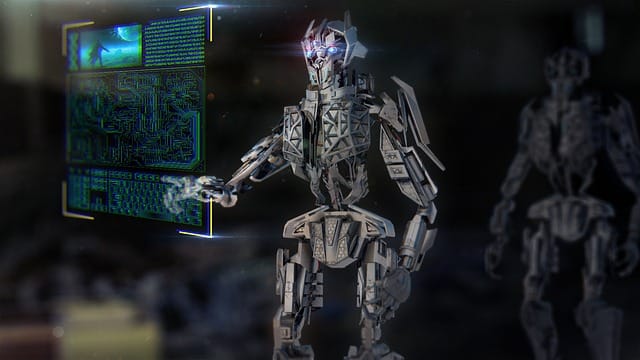At its core, machine learning is a way to make computers learn from data without needing explicit programming. Picture it like training a puppy: you show it how to sit by rewarding it with treats every time it gets it right. In the same way, you feed computers data and tell them when they’ve made the right choices. Over time, they get better at recognizing patterns and making predictions!
So, how does it all work? Well, machine learning algorithms analyze vast amounts of data – think of it as sifting through a giant box of puzzle pieces to see which ones fit together. The more data these algorithms have, the smarter they become. Let’s say you wanted to help a machine learn to identify different plants. You’d show it thousands of photos, and eventually, it would recognize that a tall green plant with pink flowers is a tulip, while a small bush with red berries is a holly.
Don’t worry; you don’t need a Ph.D. in computer science to understand this! Today, thanks to user-friendly tools and platforms, anyone can jump in and experiment with machine learning. It’s like stepping into a hobbyist workshop stocked with everything you need to create your own mini project. So, whether you’re interested in coding your own algorithm or just curious about all the buzz, understanding machine learning can open up a world of possibilities for you.
Unlocking the Code: A Beginner’s Journey into Machine Learning Explained
At its core, machine learning is all about feeding data to algorithms, which are just fancy tools that analyze that data. Think of algorithms as the personal trainers for your computer—they help it learn and improve over time. For instance, have you ever noticed how Netflix seems to know exactly what show you want to binge next? That’s machine learning in action! It analyzes your viewing habits and suggests content you might love, but it didn’t magically know that; it learned it from you!
Now, if you’re scratching your head wondering where to begin, don’t worry! You don’t need to be a tech wizard. Start small! There are tons of online courses designed for beginners. Platforms like Coursera or Udacity are like treasure maps leading you to the gold of knowledge. You’ll learn about different types of machine learning, like supervised learning (where the computer learns from labeled data) and unsupervised learning (where it finds patterns on its own).
From Novice to Knowledge: Demystifying the World of Machine Learning for Beginners
Imagine machine learning like teaching a child to ride a bike. Initially, they wobble, fall, and struggle to find their balance. But after some practice—and perhaps a few scrapes—they learn to glide confidently down the street. In the same way, machines learn from data. They start off knowing nothing (or very little), and with the right input, they begin to recognize patterns and make predictions. For example, think of how Netflix suggests shows based on what you’ve previously watched. That’s machine learning working its magic!
Now, you might be wondering, “Where do I even start?” Well, a good first step is to familiarize yourself with basic concepts like algorithms, datasets, and models. Don’t worry; you don’t need to become a coding whiz right away—just grasp the essentials. Consider online courses or tutorials as your training wheels, helping you steer through the complexities.

And what about tools? There are tons of resources out there—like Python libraries such as TensorFlow and Scikit-learn. They simplify the process, making it almost like cooking with pre-measured ingredients rather than guessing every amount. The more you explore and practice, the clearer the data jungle becomes, revealing pathways to opportunities you never imagined. So get ready to embark on this exhilarating journey!
Step into the Future: Your Essential Guide to Understanding Machine Learning
Essentially, machine learning is a branch of artificial intelligence that allows computers to learn from data. Think of it like training a puppy. Just as you reward a puppy for good behavior, machines get “trained” using data sets to recognize patterns and make predictions. For instance, ever wondered how Netflix seems to know exactly what you want to watch? That’s the magic of ML at work!
You might be thinking, “That’s great, but what does it mean for me?” Well, whether you’re a tech enthusiast or just someone curious about the future, machine learning impacts our daily lives in ways you might not even realize. From virtual assistants like Siri and Alexa to recommendation systems on your favorite shopping sites, ML is embedded in the fabric of our digital experiences.
Isn’t it fascinating that behind every click you make, there’s a system learning and evolving? And here’s the kicker: ML isn’t just for big tech companies. Small businesses can leverage it too, optimizing operations and enhancing customer service in mind-blowing ways.
So, get ready to embrace this tech revolution! Understanding machine learning is like unlocking a treasure chest of opportunities. The more you know, the better equipped you’ll be to navigate the thrilling landscape of the future.
Machine Learning 101: How to Get Started in One of Today’s Hottest Fields
First off, let’s break it down. Machine learning is essentially a subset of artificial intelligence that enables machines to learn patterns from data. Think of it like teaching a dog new tricks. At first, your pup doesn’t know what you want. But with repetition and rewards, they catch on. That’s how these algorithms work—they analyze data, adapt, and improve over time. So, how can you dive into this vast ocean of knowledge?
Start with the basics. Online platforms like Coursera and edX offer introductory courses that’ll set the stage without overwhelming you. Picture yourself scrolling through lessons from top-notch universities while sipping your morning coffee—pretty cool, right?
Next, get comfy with programming. Python is a favorite here—think of it as the friendly neighbor everyone loves. It’s easy to pick up and has tons of libraries like TensorFlow and Scikit-learn to play with. You don’t need to be a coding whiz or a math genius; just dip your toes in and gradually, you’ll swim!
Finally, never underestimate the power of community. Join forums, attend meetups, or participate in hackathons. Surrounding yourself with others will ignite your passion and keep motivation high. It’s like finding a group of friends who share your love for pizza (because who doesn’t love pizza?). So, why wait? Jump into the machine learning pool today—there’s a whole world waiting to be explored!
Transforming Data into Insights: A Beginner’s Guide to Machine Learning

At its core, machine learning is like teaching a dog new tricks. Instead of giving it commands, you feed the system tons of examples. Picture this: you have a ton of images of cats and dogs. By showing these to the machine, it learns to recognize the differences—without you explicitly telling it which is which. Isn’t that cool?
So, where do you start? First, you want to gather your data. Think of this step as collecting all your ingredients before you start cooking. Once you have that, you’ll need a way to clean and organize it because, let’s face it, nobody likes a messy kitchen! After you’ve prepped everything, it’s time to choose a model—this is your recipe. You could go for something simple like linear regression or dive into neural networks for more complex tasks.
Now, here’s where the real magic happens: training your model. It’s like giving your puppy treats every time it performs a trick correctly. As your model learns from its mistakes—it improves, becoming more accurate over time.
And as it transforms raw data into valuable insights, it’s almost like having a crystal ball that helps you make smarter decisions. Just think about it: whether you’re in business, healthcare, or any other field, the ability to extract insights from data can open doors you never knew existed!
No PhD Needed: A Beginner’s Roadmap to Grasping Machine Learning Concepts
First off, let’s talk about resources. The internet is a treasure trove! Websites like Coursera and edX offer free classes that break down complex concepts into bite-sized, digestible pieces. It’s like having a buffet of learning right at your fingertips. Just dip into the areas that intrigue you the most. Want to know about neural networks? Check! Curious about supervised learning? Double-check!
Next, grab yourself some hands-on experience. Think of it as learning to ride a bike. You wouldn’t just read about it, right? Platforms like Kaggle provide practical projects that allow you to apply your knowledge. You can start with small datasets—getting your hands dirty is where the magic happens! Remember, every expert was once a beginner, so don’t be afraid to tinker and experiment.
Now, let’s address the elephant in the room: math. Sure, it may seem daunting at first. But here’s the great news—only the basics are necessary! Brush up on statistics, algebra, and calculus as needed. Picture it as learning the grammar of a language; it helps you express more complex ideas down the line.
Lastly, join a community! Online forums, social media groups, or local meet-ups can connect you with like-minded enthusiasts. Sharing your learnings and challenges is like trading secrets in a treasure map—helpful tips can lead you to breakthroughs you didn’t even see coming. So, don’t let the thought of a PhD hold you back; start your journey today!
The ABCs of Machine Learning: Simplifying Algorithms for Beginners
Imagine teaching a child how to recognize different animals. You wouldn’t just show them a cat once and expect them to master it. You’d show them pictures, maybe even some real ones, talking about the whiskers, the purrs, and the way they frolic. This is similar to how machine learning algorithms work. They learn from data by identifying patterns, just like that child learns to differentiate a cat from a dog.
Now, let’s talk about the building blocks or “algorithms.” Think of them as recipes in your favorite cookbook. Each recipe requires specific ingredients and steps to create a delicious dish. In machine learning, algorithms take your data (ingredients) and process it to produce outcomes. There are various algorithms, like decision trees that split data into branches (like a tree growing in different directions) or neural networks, which mimic how our brains process information.

So, why should you care? Well, machine learning is revolutionizing everything from how Netflix recommends your next binge-worthy series (thanks to collaborative filtering) to how self-driving cars navigate busy streets. It’s everywhere!
Frequently Asked Questions
What Are the Different Types of Machine Learning?
Various types of machine learning include supervised learning, where models are trained on labeled data; unsupervised learning, which finds patterns in unlabeled data; and reinforcement learning, where agents learn by receiving rewards or penalties for actions. Each type serves different purposes and applications across various fields.
How Do I Get Started with Machine Learning as a Beginner?
To begin with machine learning, start by acquiring foundational knowledge in programming, preferably in Python, as well as understanding basic statistics and algebra. Explore online courses that cover machine learning principles and algorithms. Practice with hands-on projects and utilize platforms like Kaggle for real-world datasets. Engage with the community through forums and discussion groups to enhance your understanding and skills.
What Are Common Applications of Machine Learning in Everyday Life?
Machine learning is utilized in various daily applications, enhancing personal and professional experiences. Common uses include personalized recommendations on streaming services, voice assistants that understand and respond to user queries, fraud detection in banking, image recognition in social media, and targeted advertising based on user behavior. These applications leverage data patterns to improve efficiency and user engagement.
What Tools and Programming Languages Are Best for Machine Learning?
Machine learning development often involves using programming languages like Python, R, and Java due to their extensive libraries and frameworks. Python is particularly favored for its simplicity and powerful libraries such as TensorFlow and scikit-learn. R is great for statistical analysis, while Java is used for large-scale applications. In addition, tools like Jupyter Notebooks for prototyping and TensorFlow for deep learning are popular choices that enhance the workflow of machine learning projects.
What is Machine Learning and How Does It Work?
This technology enables computers to learn from data and make predictions or decisions without explicit programming. By utilizing algorithms, systems identify patterns, adapt to new information, and improve over time, allowing for applications like image recognition, recommendation systems, and natural language processing.







